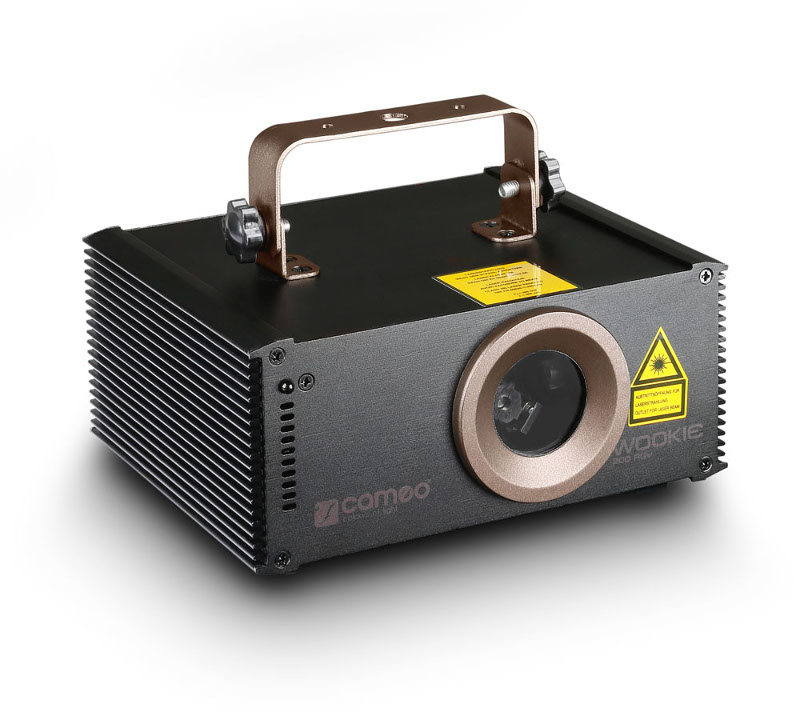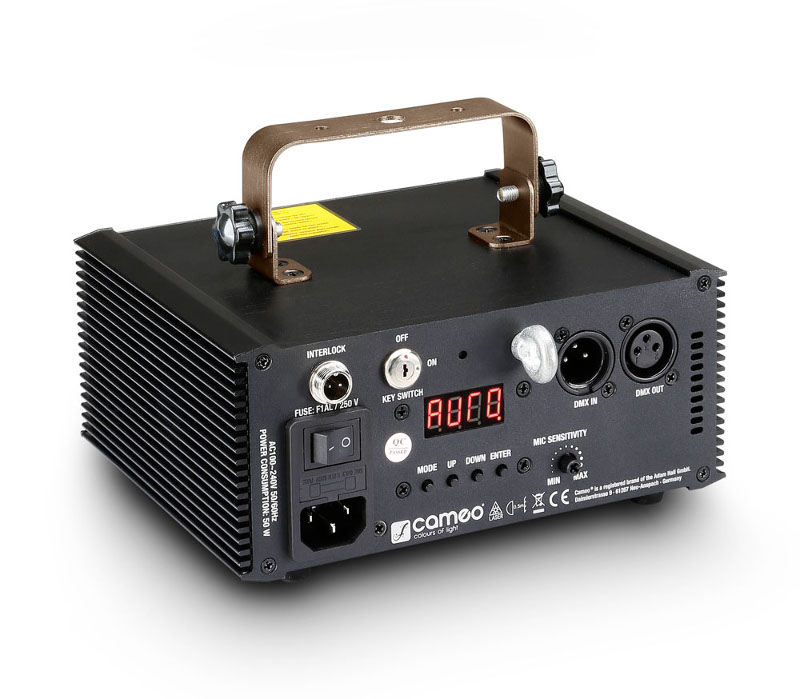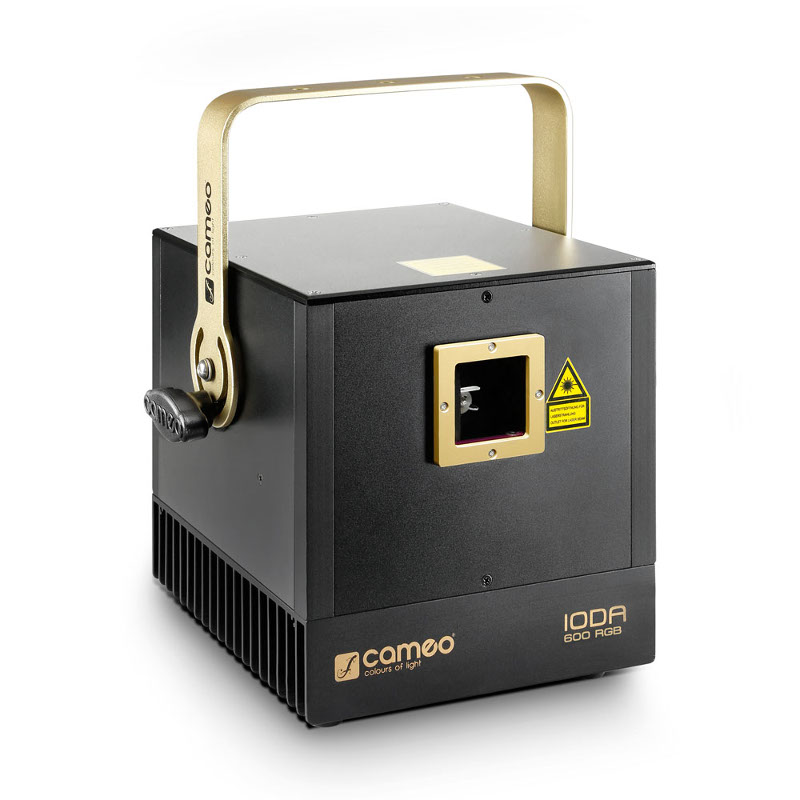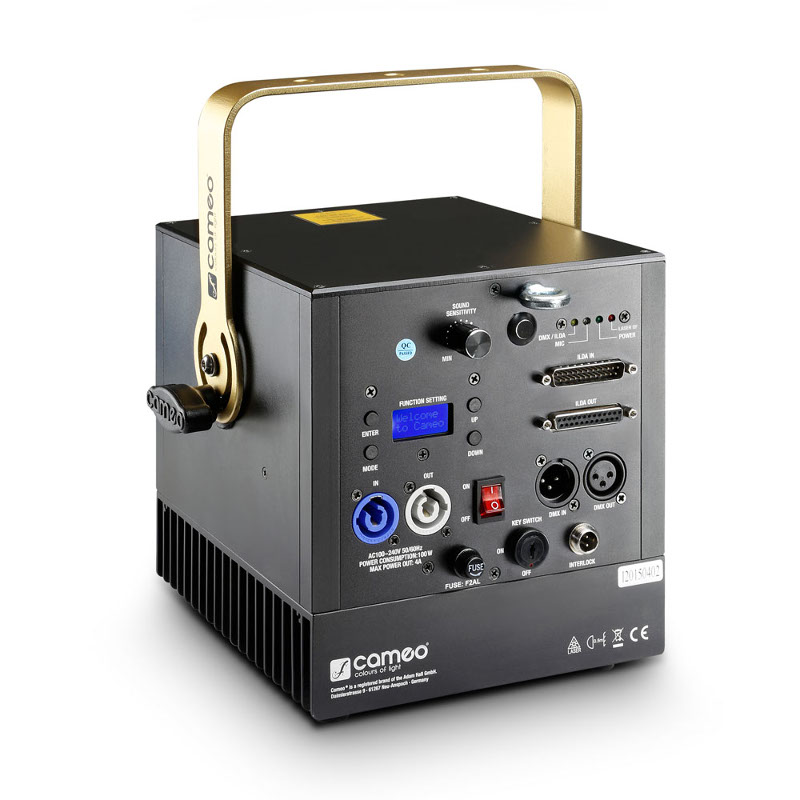Cameo Wookie 200 RGY & IODA 600 RGB – galactic show laser – a test report from pma magazine
What would the characters of the world famous space saga be without their laser guns and lightsabers? Helping light shows stay exciting, Cameo presents two show lasers, whose names remind us of two space heroes.

In the world of show lasers, Wookie is smaller than Ioda (Yoda). Unlike its shaggy cinematic counterpart, the Cameo Wookie comes in very compact housing. The workmanship makes a very good impression despite the inexpensive price class of the Cameo laser. The front is dominated by a large outlet opening, as well as the obligatory yellow safety label. The back has the standard operating elements and connections: power is connected via a cold-device cable, and if you want to manage the Wookie with a light desk, you can feed the DMX signal via a three-pin XLR plug and even loop it if needed.
Settings are controlled via a simple display and four buttons. Next to them are two control dials. One of them sets the sensitivity of the inbuilt microphones for musical control of the device, the other is intended for management of the laser performance.

Safety is the key
The safety features on the back are very important. One of these is a catch eyelet for the safety rope – this safety is required for any spotlight that is designed to be hung. An interlock interface and a key switch are located on the back of the device. Even though the size and price class of the Wookie could almost make it seem like a toy, it is a class 3 laser and therefore not completely without risk. The key, included in delivery, is needed to activate the laser beam, to prevent misuse or incorrect operation.
A plug is also included for the interlock, which can be used to get the Wookie up and running. In Germany, this class of laser is required to have a proper emergency-off switch. If there is a malfunction, which may lead to a non-moving laser bean, the laser must be able to be turned off remotely and immediately. Operation is also only permitted with the appropriate qualifications, for example, as a laser protection officer, and once the laser use has been registered with the authorities.
Wookie photon catapult
In a practical test you can easily see that the safety requirements mentioned are not unreasonable. After all, the Wookie creates an impressively bright laser effect with its 200-milliwatt performance. It can create various geometric figures and animations in red, green and yellow. However, the figures are relatively shaky, and the projection isn’t necessarily impressive. But the speed of the mirror is 5,000 points per second. This means that beautiful effects can be created in mist, which look quite fascinating.
Control is either stand-alone, music controlled or via DMX command. For stand-alone and music-controlled operation, there is also a remote control included with which you can turn the Wookie laser on and off, or switch back and forth between modes. For DMX control, you need either three or nine channels. In three-channel operation, you can set colours and shape sizes, as well as the automatic and audio mode. In nine-channel operation, it is possible to access the patterns and colours directly, as well as rotation on three axes, and to show image size and movement.
The Ioda
The Cameo Ioda (Yoda) is in a completely different league. This is already evident in the external dimensions, as the Ioda is about four times the size of the Wookie. The design is also much more robust, and what I particularly like is the strong, golden bracket that gives the device a special touch. The front is once again dominated by an outlet window and the safety label.

But there is a lot more to discover on the back. The XLR jacks are also three-pin, and the power connection is via a Powercon connector that can also be looped. The safety features are identical. The Ioda is a class 4 laser and can also only be used with the relevant qualifications and in compliance with various safety precautions. In the control connections there are also two elongated jacks. These are the co-called ILDA interfaces. These allow the connection of signals from special laser controls, which makes it possible to create individual graphics and complex laser shows.
Ioda is based on the RGB primary colours red, green and blue. This allows the mixing of further colours, and the results are impressive. The colours are very even, which means, for example, that the red and green mix together to make a real yellow, not just two different coloured lines next to each other. The speed of the motors is around 30,000 points per second. For a graphics laser this isn’t the highest possible value, but it’s really good, especially in this price class. It allows the figures and graphics to be very smooth and stable. Only when things get a little more complicated can it become a little choppy. The brightness is also impressive, making the Cameo Ioda perfect for large clubs or medium-sized stages.

ILDA and DMX
Stand-alone control is naturally also possible with this laser, but relatively pointless. Anyone operating a laser in this class is sure to have their own ideas of what they want to achieve with their device. With the described ILDA format, you can create your own graphics and shows. Even just the DMX makes a lot possible. The four DMX channels can call up 128 different pre-programmed patterns, as well as adjust the size and colours. The internal patterns include various animated animal, object and people figures, and also a countdown. In the 11-channel mode, all patterns can be freely rotated and moved on three axes.
There is always the question of which laser is good for each situation. I personally see the Wookie as a great entry-level unit. Stages in smaller clubs would also be well served with this laser. The Ioda, on the other hand, is aimed at ambitious laser fans, and is better for use in somewhat larger clubs and locations. Both lasers are also available with other laser colours, and there is also a “Luke” series, whose performance is nestled between the two series I tested.
Technical data
WOOKIE 200 RGY
Total output: 200 MW
Colour spectrum: RGY
Speed: 5 kpps
Wavelength: 650 & 532 nm
Laser class: 38
Dimensions: 180 x 90 x 192 mm
Price (RRP): €178
IODA 600 RGB
Total output: 600 MW
Colour spectrum: RGB
Speed: 30 kpps
Wavelength: 637, 532 & 447 nm
Laser class: 3 B
Dimensions: 188 x 201 x 210 mm
Price (RRP): €1,258
___________________________________________
Source: pma magazine, April 2016, Germany: http://www.pma-magazin.de/
Author: Erik Schröder
You can learn more about the Cameo laser range here:
http://www.cameolight.com/en/products/lasers/
Leave a Comment
You must be logged in to post a comment.












